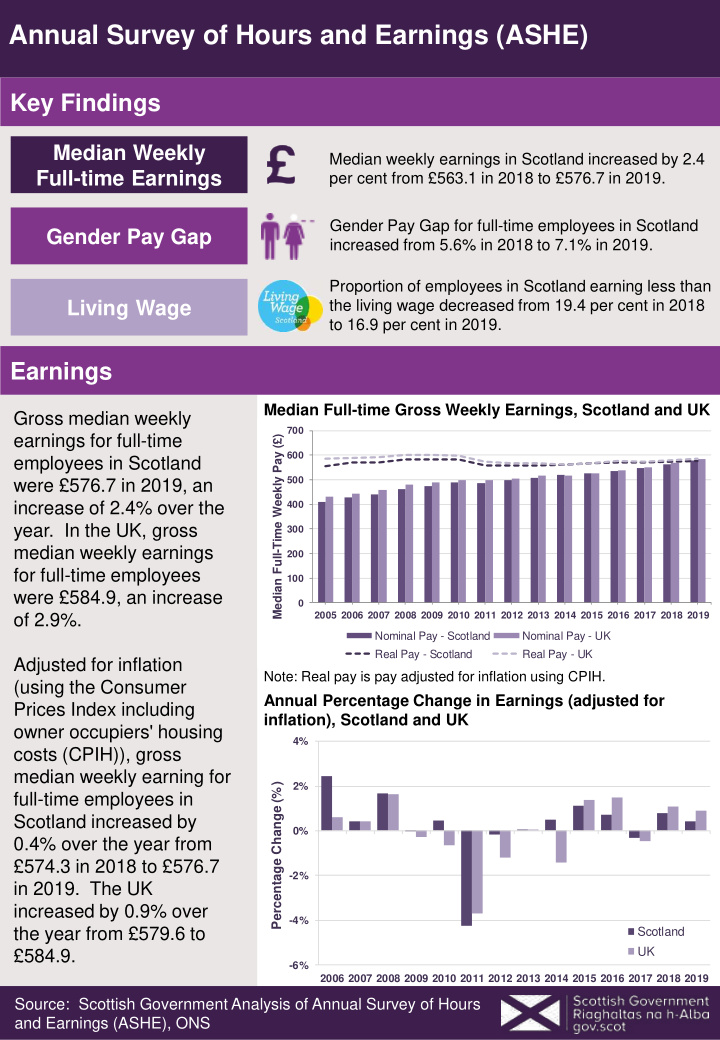



Annual Survey of Hours and Earnings (ASHE) Key Findings Median Weekly Median weekly earnings in Scotland increased by 2.4 Full-time Earnings per cent from £563.1 in 2018 to £576.7 in 2019. Gender Pay Gap for full-time employees in Scotland Gender Pay Gap increased from 5.6% in 2018 to 7.1% in 2019. Proportion of employees in Scotland earning less than Living Wage the living wage decreased from 19.4 per cent in 2018 to 16.9 per cent in 2019. Earnings Median Full-time Gross Weekly Earnings, Scotland and UK Gross median weekly 700 earnings for full-time Median Full-Time Weekly Pay (£) 600 employees in Scotland 500 were £576.7 in 2019, an increase of 2.4% over the 400 year. In the UK, gross 300 median weekly earnings 200 for full-time employees 100 were £584.9, an increase 0 2005 2006 2007 2008 2009 2010 2011 2012 2013 2014 2015 2016 2017 2018 2019 of 2.9%. Nominal Pay - Scotland Nominal Pay - UK Real Pay - Scotland Real Pay - UK Adjusted for inflation Note: Real pay is pay adjusted for inflation using CPIH. (using the Consumer Annual Percentage Change in Earnings (adjusted for Prices Index including inflation), Scotland and UK owner occupiers' housing 4% costs (CPIH)), gross median weekly earning for Percentage Change (%) 2% full-time employees in Scotland increased by 0% 0.4% over the year from £574.3 in 2018 to £576.7 -2% in 2019. The UK increased by 0.9% over -4% the year from £579.6 to Scotland UK £584.9. -6% 2006 2007 2008 2009 2010 2011 2012 2013 2014 2015 2016 2017 2018 2019 Source: Scottish Government Analysis of Annual Survey of Hours and Earnings (ASHE), ONS
Annual Survey of Hours and Earnings (ASHE) Key Findings Earnings Median Gross Weekly Earnings by Gender and Work In the last year, women’s Pattern, Scotland, 2019 619.9 overall earnings increased 576.7 All 566.8 527.0 at a faster rate than for Men 470.0 men. 394.4 Women £ per For full-time 210.4 week 204.5 176.5 Median gross weekly earnings for women increased by 2.1 per cent to 4.9 4.6 4.2 3.8 3.6 3.6 £527.0 compared with an 2.3 Change 2.4 2.1 on Year increase of 3.6 per cent to (%) £619.9 for men. All Full-time Part-time Gender Pay Gap Gender Pay Gap by Work Pattern, Scotland and UK, 2019 The Gender Pay Gap for all 20 Scotland employees in Scotland has Gender Pay Gap (%) UK decreased from 15.0 per 10 cent in 2018 to 14.3 per cent in 2019, the lowest 7.1 8.9 14.3 17.3 since the series began in 0 -3.1 -8.6 1997. -10 Over the last year, the Full-time Part-time All Gender Pay Gap for full- Gender Pay Gap for Median Full-Time Hourly Earnings time employees in Scotland (excluding overtime), Scotland and UK has increased from 5.6 per 25 cent to 7.1 per cent while it UK has increased from 8.6 per Scotland 20 cent to 8.9 per cent for the Gender Pay Gap (%) UK. 15 The Gender Pay Gap for 10 full-time employees in Scotland has been lower 5 than in the UK since 2003. 0 1997 1999 2001 2003 2005 2007 2009 2011 2013 2015 2017 2019 Source: Scottish Government Analysis of Annual Survey of Hours and Earnings (ASHE), ONS
Annual Survey of Hours and Earnings (ASHE) Key Findings Living Wage 400,000 employees (16.9 Proportion of Employees (18+) earning less than the real Living Wage, Scotland per cent of people in employment) in Scotland Proportion earning less than the Living earned less than the Living 20.1 19.6 19.3 19.4 Wage (£9.00) in 2019, 18.8 18.6 18.4 16.9 decreasing from 473,000 in 2018. Wage (%) The proportion of employees earning less than the Living Wage remained relatively constant between 2012 and 2016, decreasing to 16.9 per cent in 2019. 2012 2013 2014 2015 2016 2017 2018 2019 Background About the Annual Survey of Hours and Earnings The Annual Survey of Hours and Earnings (ASHE) is the official source of UK earnings and hours worked estimates. ASHE data is published annually by the Office for national Statistics (ONS) and is based on a 1 per cent sample of the Pay As You Earn (PAYE) system. Further details: https://www.ons.gov.uk/employmentandlabourmarket/peopleinwork/earningsandworkinghours/methodologie s/annualsurveyofhoursandearningslowpayandannualsurveyofhoursandearningspensionresultsqmi Glossary CPIH: The Consumer Prices Index including owner occupiers’ housing costs (CPIH) is the most comprehensive measure of inflation. Further details can be found at the following link: https://www.ons.gov.uk/economy/inflationandpriceindices/datasets/consumerpriceinflation Work Patterns: Full-time is defined as employees working more than 30 paid hours per week (or 25 or more hours for teaching professions). Part-time is defined as employees working less than or equal to 30 paid hours per week (or less than 25 hours for the teaching professions). Gender Pay Gap is calculated as the difference between the average hourly earnings (excluding overtime) for men and women as a proportion of the average hourly earnings (excluding overtime) for men. Real Living Wage: The real living wage rates have been independently calculated by the Resolution Foundation according to the cost of living based on household goods and services. Current and historical living wage rates can be found at the following link: https://livingwage.org.uk/calculation Contact Labour Market Statistics team Published: 29 th October 2019 Tel: 0131 244 6783 Email: lmstats@gov.scot Source: Scottish Government Analysis of Annual Survey of Hours and Earnings (ASHE), ONS
Recommend
More recommend